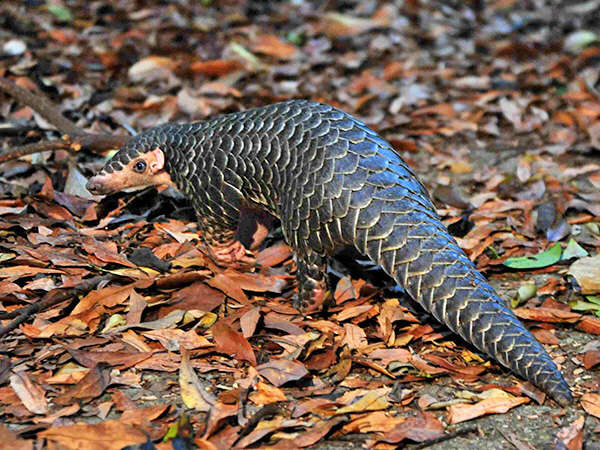 |
Order : PHOLIDOTA
Family : Manidae
Species : Manis pentadactyla
Head-body length : Up to 58 cm
Tail length : Up to 38 cm
Weight : up to 5 kg ?
The Chinese Pangolin is categorised by IUCN (Challender
et al, 2014) as Critically Endangered: its numbers are in steep decline as a
result of
relentless hunting pressure for its meat and for its scales, which are used
in traditional medicine.
This species, which occurs in the north of the region, is
smaller-bodied than the closely-related, and more widespread,
Sunda Pangolin Manis javanica, which
occurs in the south. Compared with Manis javanica, it has longer
ears, longer front claws and a shorter, less flexible tail. The scales on
top of its head do not extend fully to its nostrils.
The Chinese Pangolin occurs in a wide range of forest types (primary,
secondary, bamboo) as well as
grasslands and agricultural areas. It feeds on small invertebrates such as ants,
and particularly termites. It is both terrestrial and arboreal, and is
mainly active at night. By day it typically rests in the cool of its burrow,
which they are able to excavate themselves.
This species occurs in northern parts of the Indian subcontinent
(including northern India, Bhutan, Nepal and Bangladesh), parts of northern
Myanmar, northern Indochina (Thailand, Laos, Vietnam), and parts of
southern China (including Hong Kong and Taiwan). Its present range is
probably much reduced, as a result of relentless hunting pressure.
Figs 1 to 3 : Examples from Hong Kong, in lowland secondary forest.
Photos thanks to Gary Ades (Kadoorie Farm & Botanic Garden).
References :
Challender, D., Baillie, J., Ades, G., Kaspal, P., Chan, B., Khatiwada, A.,
Xu, L., Chin, S., KC, R., Nash, H. & Hsieh, H. 2014. Manis pentadactyla.
The IUCN Red List of Threatened Species 2014: e.T12764A45222544.
Francis, C.M., 2001. Mammals of South-east Asia. New Holland.
Links :
Kadoorie Farm & Botanic
Garden, Hong Kong
|